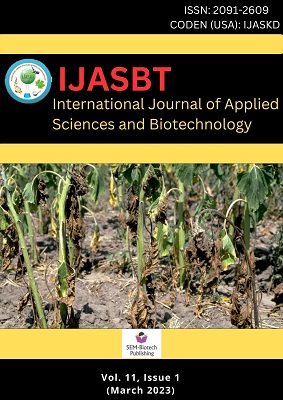Goat Feed Resources and Feeding Management in Mid-Hill of Nepal
DOI:
https://doi.org/10.3126/ijasbt.v11i1.53701Keywords:
Feed resources, goat, farming, NepalAbstract
This study was commissioned to assess studies on feeding resources and feeding management of goat in mid hills of Nepal. During the study, 162 goat farms located in Ghiring and Baradi of Tanahun districts in Nepal were surveyed, and a semi-structured questionnaire was administered to each farm. Farmers in this region prefer integrating livestock raising with crop production. The majority of the farms surveyed kept indigenous Khari goats, either in pure flocks or through crossbreeding. The types of goat farming were commercial (8.02%), semi-commercial (29.01%) and subsistence (62.96%). The nature of management practices for goat farmers was intensive (70.99%), semi-intensive (14.81%) and free range (14.20%). Farmers grazed their livestock in different locations, including their own land (48.77%), forests (22.22%), and other places (29.01%). The selection of fodder species by farmers varied depending on the availability of different species in the mid hills, reflecting differences in their perception and preference. Among the top fodder species highly preferred by the farmer in summer season are Ficus cunia followed by Bauhinia longifolia, Ficus hispida, Castanopsis indica and Ficus auriculata. Fodder species highly preferred by the farmers in winter season are Litsea polyantha followed by Drepanostachyum khasianum, Shorea robusta, Terminalia elliptica and Mangifera indica. Goat production is an essential aspect of subsistence farming, providing both meat and cash income. Consequently, this study recommends promoting locally preferred tree fodder species and supplementing them with feed during different seasons, based on their availability and local preferences. Such strategies can help to improve goat production and support sustainable livelihoods for farmers in the region.
Int. J. Appl. Sci. Biotechnol. Vol 11(1): 15-24
Downloads
Downloads
Published
How to Cite
Issue
Section
License
Copyright (c) 2023 International Journal of Applied Sciences and Biotechnology

This work is licensed under a Creative Commons Attribution-NonCommercial 4.0 International License.




